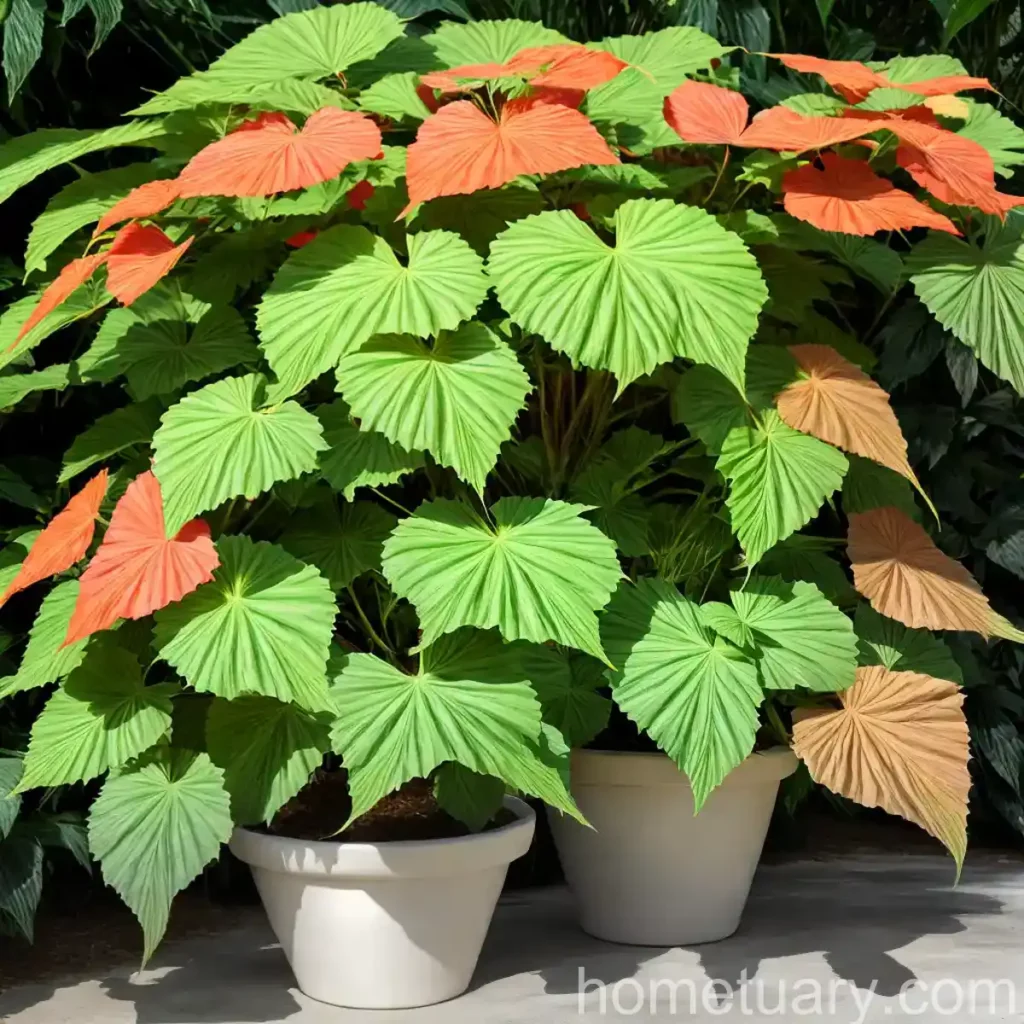Rex Begonia Vine (Cissus Javana): An Ultimate Care Guide
Plants play a significant role in adding beauty and serenity to our surroundings. Among the countless varieties of plants, the rex begonia vine (Cissus javana) stands out as a charming and vibrant addition to any indoor or outdoor space. In this comprehensive guide, we will delve into the fascinating world of Cissus javana, exploring its culture, uses, care tips, propagation methods, common diseases, and much more.
What is Plant: Rex Begonia Vine (Cissus Javana)
Rex begonia vine, scientifically known as Cissus javana, is a species of trailing vine belonging to the Vitaceae family. Native to Southeast Asia, this stunning plant is known for its heart-shaped, deep-green leaves with splashes of silver and maroon, making it an eye-catching addition to gardens, balconies, and indoor spaces. As a climbing vine, it possesses a natural cascading growth habit, making it an ideal choice for hanging baskets or trailing from shelves and containers.
Key Takeaways – Rex Begonia Vine (Cissus Javana)
Before we dive into the detailed care guide for rex begonia vine, let’s explore the core takeaways that will be covered in this comprehensive guide:
- Culture
- Uses
- Water
- Sunlight
- Fertilizer
- Soil
- Pruning
- Propagation
- Container Popularity
- Common Diseases
- Common Pests
- Botanist’s Tips
- Fun Facts
- Links to External Resources
Now that we have an overview of what to expect, let’s explore each of these aspects in detail to ensure the successful care and maintenance of the rex begonia vine.
Culture of Rex Begonia Vine (Cissus Javana)
Understanding the cultural requirements of the rex begonia vine is crucial for fostering its healthy growth and vibrant foliage. Let’s delve into the core cultural aspects including its uses, water and sunlight needs, soil preferences, and more.
Uses
Rex begonia vine, with its striking foliage and trailing growth habit, serves various purposes in both indoor and outdoor settings. Some of its uses include:
- Ornamental Plant: Its visually appealing foliage and trailing habit make it an ideal choice for ornamental purposes, adding a touch of natural beauty to any space.
- Hanging Baskets: Due to its cascading growth, rex begonia vine is often used in hanging baskets, allowing its vines to gracefully trail downwards.
- Vertical Gardens: Its climbing nature makes it suitable for vertical gardens or trellises, adding a lush green element to vertical spaces.
Water
Proper watering is essential for the health and vitality of the rex begonia vine. Maintaining the right balance of moisture in the soil is crucial to prevent issues such as root rot or dehydration. When it comes to watering this plant, keep the following tips in mind:
- Moderate Watering: Aim to water the rex begonia vine consistently, allowing the soil to dry out slightly between waterings to prevent waterlogged conditions.
- Avoid Overwatering: It’s essential to avoid overwatering, as excessively damp soil can lead to root rot and other moisture-related issues.
- Check Soil Moisture: Before watering, check the soil moisture by inserting your finger into the soil. Water the plant only if the top inch of the soil feels dry to the touch.
Sunlight
Providing adequate sunlight is crucial for the rex begonia vine to thrive and maintain its vibrant foliage. Here are some key considerations regarding its sunlight requirements:
- Bright Indirect Light: Rex begonia vine thrives in bright, indirect light. Place it near a window where it can receive plenty of natural light without being exposed to direct sunlight, which can cause leaf burn.
- Indoor Placement: When kept indoors, ensure that the plant is positioned in a well-lit area with ample natural light to promote healthy growth.
Fertilizer
Fertilizing the rex begonia vine is essential to support its growth and development. Choosing the right type of fertilizer and applying it at the appropriate frequency can make a notable difference in the plant’s overall health. Here’s what you need to know about fertilizing this stunning vine:
- Balanced Fertilizer: Use a balanced, water-soluble fertilizer formulated for indoor plants or foliage plants. Look for a fertilizer with a balanced NPK ratio, such as 10-10-10 or 20-20-20, to provide essential nutrients for the rex begonia vine.
- Application Frequency: During the growing season, fertilize the rex begonia vine every 4-6 weeks to support its growth and ensure the availability of essential nutrients.
Soil for Rex Begonia Vine (Cissus Javana)
Choosing the right type of soil is crucial to provide an optimal growing medium for the rex begonia vine. The soil should offer good drainage while retaining adequate moisture and nutrients to support the plant’s overall health. Consider the following soil-related aspects when caring for the rex begonia vine:
- Well-Draining Soil: Opt for a well-draining potting mix to prevent waterlogging, which can lead to root rot and other moisture-related issues.
- Peat-Based Mix: A peat-based potting mix is suitable for rex begonia vine, providing good moisture retention while allowing excess water to drain freely.
- Added Amendments: Incorporating perlite or orchid bark into the potting mix can further improve drainage and aeration, creating an optimal growing environment for the plant’s roots.
Pruning the Rex Begonia Vine
Pruning is an essential aspect of rex begonia vine care, helping maintain its desired shape, promote bushier growth, and remove any damaged or overgrown parts. By following proper pruning techniques, you can keep the plant looking healthy and vibrant. Consider the following tips when pruning the rex begonia vine:
- Regular Pruning: Perform regular pruning to manage the plant’s growth and shape. Removing excess growth can help maintain a tidy appearance and promote new growth.
- Deadheading Flowers: If your rex begonia vine produces flowers, deadhead them as they fade to encourage additional flowering and prevent the plant from expending energy on producing seeds.
Propagation of Rex Begonia Vine
Propagating the rex begonia vine allows you to expand your plant collection and share its beauty with others. Whether you prefer propagation through stem cuttings or water propagation, there are several methods to propagate this stunning vine. Here’s an overview of the propagation methods for the rex begonia vine:
- Stem Cuttings: Propagate rex begonia vine by taking stem cuttings from a healthy, mature plant. Ensure that the cuttings have at least two nodes, and place them in a potting mix to encourage root development.
- Water Propagation: Place the stem cuttings in a container of water, ensuring that a portion of the stem is submerged while the nodes remain above the water level. Change the water regularly and wait for the roots to develop before transplanting the cuttings into soil.
Container Popularity for the Rex Begonia Vine
The rex begonia vine’s trailing and cascading growth habit makes it a popular choice for container gardening, particularly in hanging baskets and decorative containers. When it comes to selecting the right container for your rex begonia vine, consider the following tips:
- Hanging Baskets: Choose a well-draining hanging basket with sufficient depth to accommodate the plant’s trailing vines and promote healthy growth.
- Decorative Containers: Opt for decorative pots or containers with proper drainage holes to support the rex begonia vine’s growth while adding a touch of style to your space.
Common Diseases of Rex Begonia Vine
While rex begonia vine is relatively low-maintenance, it is susceptible to certain diseases that can affect its overall health and appearance. Being aware of these common diseases and their symptoms can help you take proactive measures to protect your rex begonia vine. Here are some common diseases that may affect this charming plant:
- Powdery Mildew: This fungal disease can manifest as a powdery white coating on the leaves, compromising the plant’s overall health. Provide good air circulation and avoid overhead watering to prevent powdery mildew.
- Leaf Spot: Leaf spot diseases can cause dark or discolored spots to appear on the rex begonia vine’s foliage. Prune affected parts and ensure proper ventilation to prevent the spread of the disease.
Common Pests Affecting Rex Begonia Vine
In addition to diseases, rex begonia vine may also encounter pests that can compromise its health and vitality. Understanding the common pests and their control methods is essential for maintaining a pest-free environment for this lovely vine. Here are some common pests that may affect the rex begonia vine:
- Aphids: These small, soft-bodied insects can cluster on the rex begonia vine’s tender new growth, sucking sap from the plant and causing leaf distortion. Use insecticidal soap or neem oil to control aphid infestations.
- Spider Mites: These tiny arachnids can cause stippling and webbing on the rex begonia vine’s foliage, leading to weakened and discolored leaves. Rinse the plant with water and apply horticultural oil to manage spider mite infestations.
Botanist’s Tips for Rex Begonia Vine Care
For plant enthusiasts who are eager to ensure the optimal care and growth of rex begonia vine, here are some expert tips to consider:
- Regular Monitoring: Keep a close eye on your rex begonia vine, monitoring its growth, foliage, and overall health to identify any potential issues at an early stage.
- Proper Support: If you’re growing rex begonia vine as a climber, provide suitable support such as a trellis or moss pole to guide its growth and prevent sprawling.
Fun Facts about Rex Begonia Vine
To add a touch of fascination to your understanding of the rex begonia vine, here are some delightful and intriguing fun facts about this captivating plant:
- Variegated Foliage: Rex begonia vine often showcases variegated foliage, featuring a striking combination of green, silver, and maroon colors that add a unique aesthetic appeal to the plant.
- Climbing Abilities: Due to its climbing nature, rex begonia vine can elegantly trail down from shelves, window sills, or containers, creating a graceful and natural display.
Links to External Resources
For additional insights and information on rex begonia vine care, propagation, and other related topics, here are some valuable external resources to explore:
- American Begonia Society
- Royal Horticultural Society – Begonias
- University of Florida IFAS Extension – Begonia
In conclusion, the rex begonia vine (Cissus javana) holds a special place in the world of ornamental plants, offering a delightful combination of beauty, resilience, and low-maintenance care. By understanding its cultural needs, optimal growing conditions, and potential challenges, plant enthusiasts can nurture and enjoy the lush foliage and cascading vines of this charming plant.
By incorporating the tips and guidelines outlined in this comprehensive care guide, you can embark on a rewarding journey of growing and caring for the rex begonia vine, adding a touch of natural elegance to your indoor or outdoor spaces. Whether you’re a seasoned plant lover or a novice enthusiast, the enchanting allure of the rex begonia vine is sure to captivate and inspire your passion for gardening and horticulture.
Remember, each cascading vine and variegated leaf of the rex begonia vine has a story to tell, serving as a living testament to the beauty and wonder of the natural world.
Happy gardening!
In this comprehensive guide, we covered various aspects of rex begonia vine care, including its cultural preferences, propagation methods, common issues, and much more. Whether you’re a beginner or experienced gardener, this guide aimed to provide valuable insights into nurturing the rex begonia vine for optimal growth and vibrancy.















